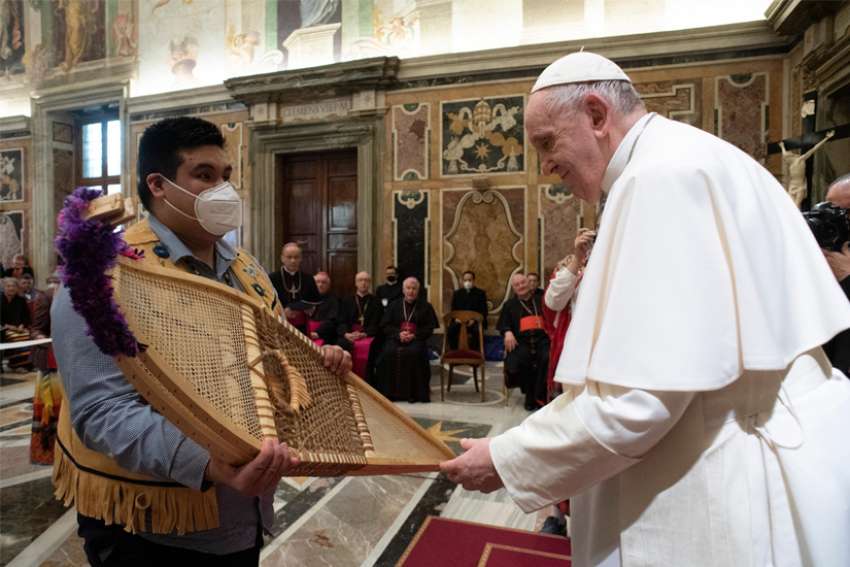The Canadian Conference of Catholic Bishops’ Papal Visit to Canada Secretariat says the trip will enable Pope Francis “to listen and dialogue with Indigenous peoples, to express his heartfelt closeness and to address the impact of colonization and the participation of the Catholic Church in the operation of residential schools throughout Canada.”
This is a very welcome move. Among other things, Pope Francis’ visit is a solid step in fulfilling Section 58 of the Truth and Reconciliation Commission of Canada’s (TRCC) Calls to Action report.
Key to this trip is the theory and practice of “apology.” What does apology mean, what is its role, and what are the elements that comprise an authentic apology?
Philosopher Mihaela Mihai, from the University of York in the United Kingdom, defines apology as being “the act of declaring one’s regret, remorse or sorrow for having insulted, failed, injured, harmed or wronged another.” Apologies can be private or public.
Mihai says the act of apologizing “recognizes the offended as an equal moral agent. Psychologically, an apology aims to meet the victim’s psychological needs of recognition,” which, ideally, restores the injured party’s self-respect.
Canada’s Indigenous peoples were mistreated, not only by the Church but by governments and corporations among others in the wider society. These abuses have damaged many Indigenous peoples’ respect for their cultures and themselves.
There is a growing movement in Canada for First Peoples to reclaim their cultures and positively affirm their identities and ways of life as the wider society becomes more aware of First Peoples’ rights and the injury done to them.
The papal apology is a great first start in bringing about this affirmation and restoration. We are exhorted, through the Gospels, papal encyclicals and other Church teachings, to respect and protect the rights of those victimized by selfishness and greed. Pope Francis’ Fratelli Tutti and Laudato Si’ are particularly vocal on justice for the poor and marginalized.
But the apology doesn’t stop as merely an act of contrition; there are action items associated with it. In a 2016 paper Ohio State University researcher Roy Lewicki and team identify six elements of an apology: expression of regret; explanation of what went wrong; acknowledgment of responsibility; declaration of repentance; offer of repair; and request for forgiveness. Of this list, the two most important items are acknowledging responsibility and taking steps to repair the damage, says the research.
Mihai agrees: “The “sincerity” of collective apologies should be measured in terms of what follows from the act. Changes in the norms and practices of the collective, reparations, compensation, or memorialization projects give concreteness to the symbolic act of apologizing.”
Various groups have different ideas about the particular actions that the Catholic Church could take to bring the apology to life, ultimately resulting in much-needed healing and restoration.
The way forward should be charted largely based on the needs of the Indigenous peoples to whom the apology is aimed. These needs have been expressed in Sections 58 through 61 of the TRC’s Calls to Action, which outlines measures detailed under the 2006 Indian Residential Schools Settlement Agreement. Schedule O-3 contains the agreement with Catholic Church entities.
In addition to the apology, measures in the settlement include: programs to educate congregations and clergy about residential schools; curriculum for all student clergy, and all clergy and staff who work in Indigenous communities on the need to respect Indigenous spirituality; and funding for various reconciliation, healing and cultural programs and services.
But there’s another side to reconciliation: the forgiveness granted by the injured party.
A 2013 Ottawa Citizen article incl udes the Archdiocese of Ottawa’s Fr. Geoffrey Kerslake’s view that, in the apology process, the injured party “needs to graciously accept the apology and extend forgiveness for the apology to ‘work’ so to speak.”
Kerslake refers to the G. K. Chesterton quote: “The injured party does not want to be compensated because he has been wronged; he wants to be healed because he has been hurt.”
If Pope Francis’ apology is satisfactory to Canada’s Indigenous peoples, the Pontiff’s statement should be accepted, and a way forward negotiated.
(Majtenyi is a public relations officer specializing in research at an Ontario university.)


